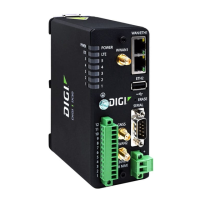Applications Use Python to control the color of multi-colored LEDs
IX30 User Guide
667
Example digidevice.sms code
The following example code receives an SMS message and sends a response:
#!/usr/bin/python3.6
import os
import threading
import sys
from digidevice.sms import Callback, send
COND = threading.Condition()
def sms_test_callback(sms, info):
print(f"SMS message from {info['content.number']} received")
print(sms)
print(info)
COND.acquire()
COND.notify()
COND.release()
def send_sms(destination, msg):
print("sending SMS message", msg)
if len(destination) == 10:
destination = "+1" + destination
send(destination, msg)
if __name__ == '__main__':
if len(sys.argv) > 1:
dest = sys.argv[1]
else:
dest = '+15005550006'
my_callback = Callback(sms_test_callback, metadata=True)
send_sms(dest, 'Hello World!')
print("Please send an SMS message now.")
print("Execution halted until a message is received or 60 seconds have
passed.")
# acquire the semaphore and wait until a callback occurs
COND.acquire()
try:
COND.wait(60.0)
except Exception as err:
print("exception occured while waiting")
print(err)
COND.release()
my_callback.unregister_callback()
Use Python to access serial ports
You can use the Python serial module to access serial ports on your IX30 device that are configured to
be in Application mode. See Configure Application mode for information about configuring a serial
port in Application mode.
To use Python to access serial ports:
1. Select a device in Remote Manager that is configured to allow shell access to the admin user,
and click Actions > Open Console. Alternatively, log into the IX30 local command line as a user
with shell access.

